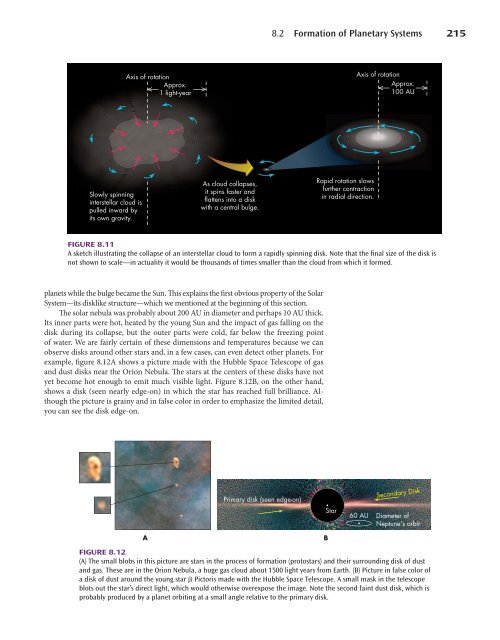Chapter 8
Chapter 8
Chapter 8
You also want an ePaper? Increase the reach of your titles
YUMPU automatically turns print PDFs into web optimized ePapers that Google loves.
Slowly spinning<br />
interstellar cloud is<br />
pulled inward by<br />
its own gravity.<br />
Axis of rotation<br />
Approx.<br />
1 light-year<br />
As cloud collapses,<br />
it spins faster and<br />
flattens into a disk<br />
with a central bulge.<br />
FIGURE 8.11<br />
A sketch illustrating the collapse of an interstellar cloud to form a rapidly spinning disk. Note that the fi nal size of the disk is<br />
not shown to scale—in actuality it would be thousands of times smaller than the cloud from which it formed.<br />
planets while the bulge became the Sun. Th is explains the fi rst obvious property of the Solar<br />
System—its disklike structure—which we mentioned at the beginning of this section.<br />
Th e solar nebula was probably about 200 AU in diameter and perhaps 10 AU thick.<br />
Its inner parts were hot, heated by the young Sun and the impact of gas falling on the<br />
disk during its collapse, but the outer parts were cold, far below the freezing point<br />
of water. We are fairly certain of these dimensions and temperatures because we can<br />
observe disks around other stars and, in a few cases, can even detect other planets. For<br />
example, fi gure 8.12A shows a picture made with the Hubble Space Telescope of gas<br />
and dust disks near the Orion Nebula. Th e stars at the centers of these disks have not<br />
yet become hot enough to emit much visible light. Figure 8.12B, on the other hand,<br />
shows a disk (seen nearly edge-on) in which the star has reached full brilliance. Although<br />
the picture is grainy and in false color in order to emphasize the limited detail,<br />
you can see the disk edge-on.<br />
Primary disk (seen edge-on)<br />
A B<br />
8.2 Formation of Planetary Systems 215<br />
Rapid rotation slows<br />
further contraction<br />
in radial direction.<br />
Axis of rotation<br />
Approx.<br />
100 AU<br />
60 AU Diameter of<br />
Neptune’s orbit<br />
FIGURE 8.12<br />
(A) The small blobs in this picture are stars in the process of formation (protostars) and their surrounding disk of dust<br />
and gas. These are in the Orion Nebula, a huge gas cloud about 1500 light years from Earth. (B) Picture in false color of<br />
a disk of dust around the young star β Pictoris made with the Hubble Space Telescope. A small mask in the telescope<br />
blots out the star’s direct light, which would otherwise overexpose the image. Note the second faint dust disk, which is<br />
probably produced by a planet orbiting at a small angle relative to the primary disk.<br />
Star<br />
Secondary Disk<br />
arn12176_ch08.indd 215 8/3/09 8:39:42 AM

















